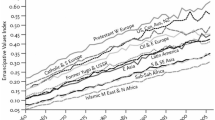Abstract
This article reviews the law regarding Title VII employment discrimination protection from religious discrimination. The issues surrounding the principal legal protection in this regard are explored in the context of a recent controversial case in which an author, Forrest Mims, was not hired as a regular contributor forScientific American magazine, ostensibly because of his belief in the theory of creation over the theory of evolution. The definition of what constitutes a protected religious belief or practice is seen to have expanded over time. However, a belief in creationism is not necessarily seen as being tantamount to a religious belief under present legal interpretation of Title VII. The implications of this finding for future needed Title VII revision are discussed.
Similar content being viewed by others
References
Ansonia Board of Education v. Ronald Philbrook, 107 S.Ct. 367 (1986).
Apes and apostates (1990).The Economist 303(7504), 33–34.
Brenner v. Diagnostic Center Hospital, 671 F2d 141 (5th Cir. 1982).
Brierton, T. D. (1988). Religious discrimination in the workplace: Who's accommodating who?Labor Law Journal, 39(5), 299–306.
Claybaugh v. Pacific Northwest Bell Telephone Co., 355 F. Supp. 1 (D.Or. 1973).
Crossfire (Cable News Network broadcast, October 31, 1990).
Cummins v. Parker Seal Co., 433 US 903 (1977).
Davis, B. (1990).Scientific American drops plans to hire columnist who believes in creationism.The Wall Street Journal, (October 22, 1990), A7A.
Davis v. Beason, 133 US 33 (1890).
deCamp, L. S. (1968).The Great Monkey Trial. Garden City, NY: Doubleday.
Diaz v. Pan American Airways, 442 F2d 385 (5th Cir. 1971).
Dong Shik Kim, et al. v. The Dekalb Farmer's Market, No. 1-88CV2767HTW (N.D. Ga. 1988).
Eastland, T. (1991).Scientific American on trial.The American Spectator, 24(2), 32–34.
Edwards v. Aguillard, 479 US 1004, 93 LE 2d 697 (1987).
Fekito v. Standard Brands, Inc., 424 F2d 331 (3rd Cir. 1970).
Feldestein v. The Christian Science Monitor, 30 FEP 1842 (E.D. Mass. 1983).
Flygare, T.L. (1987). Supreme Court strikes down Louisiana creationism act.Phi Delta Kappan, 69(1), 77–79.
Fowler, v. Rhode Island, 345 US 67 (1953).
Ginger, R. (1958).Six Days or Forever? Tennessee v. John Thomas Scopes. Boston: Beacon Press.
Gould, S. J. (1988). Genesis and genealogy: Are you interested in the rock of ages, or the age of rocks?Natural History, 97(9), 12–20.
In the beginning God created... (1990).The Economist,312(7616), 17.
Kelly, E. P., & Aalberts, R. J. (1990). Americans with Disabilities Act: Undue hardship for private sector employers?Labor Law Journal 41(10), 675–684.
Kern v. Dynaelectron Corp., 577 F. Supp. 1196 (N.D. Tex. 1983).
Mims, F. M., III. (1990a). Sunspots and how to observe them safely.Scientific American, 262(6), 130–13
Mims, F. M., III. (1990b). How to monitor ultraviolet radiation from the sun.Scientific American, 263(2), 106–109.
Mims, F. M., III. (1990c). A remote-control camera that catches the wind and captures the landscape.Scientific American, 263(4), 126–129.
Mitchell, C. E. (1990). New age training programs: In violation of relgious discrimination laws?Labor Law Journal, 41(7), 410–416.
Mormon Church v. Amos. 107 S.Ct. 2862 (1987).
No religion here (1990).New Scientist 128(1743), 22–30.
Pullum, S. J. (1988). Some principles concerning religious discrimination in the workplace.SAM Advanced Management Journal, 53(1), 33–38.
Redmond v. GAF Corporation, 1574 F2d 897 (7th Cir. 1978).
Science's litmus test (1991).Harper's Magazine,282(1960), 28–32.
Scopes v. State, 154 Tenn. 105, 289 S.W. 363 (1927).
Sharpe, P. (1991). Big bang.Texas Monthly, 19(1), 40–43.
Sidey, K. (1990).Scientific American drops Christian writer with creation beliefs.Christianity Today, 34(17), 36.
Audra Sommers, a/k/a Timothy K. Cornish v. Budget Marketing, 667 F2d 748 (8th Cir. 1982).
Theriault v. Carlson, 495 F2d 390 (5th Cir. 1974).
Trans World Airlines v. Hardison, 432 US 63 (1977).
Turpen v. Missouri-Kansas-Texas Railway Co., 736 F.2d. 1022 (4th Cir. 1984).
Ulane v. Eastern Airlines, Inc., 742 F.2d. 1081 (4th Cir. 1984).
United States v. Seeger, 380 US 163 (1965.).
Weisberg, J. (1990). No-run homer.The New Republic, 203(22), 47.
West, X. (1982). Balanced treatment for creation science and evolution science in public school instruction.Act. La. Rev. Stat. Ann., 17, 286.1–17.286.7
Yott v. North American Rockwell Corp, 502 F2d 398 (1974).
Young. V. Southwestern Savings & Loan Ass'n., 509 F2d 496 (5th Cir. 1975).
Author information
Authors and Affiliations
Rights and permissions
About this article
Cite this article
Wyld, D.C., Cappel, S.D. Believing in employment discrimination: The case of Forrest Mims,Scientific American, and title VII protection. Employ Respons Rights J 5, 1–11 (1992). https://doi.org/10.1007/BF01407804
Issue Date:
DOI: https://doi.org/10.1007/BF01407804




